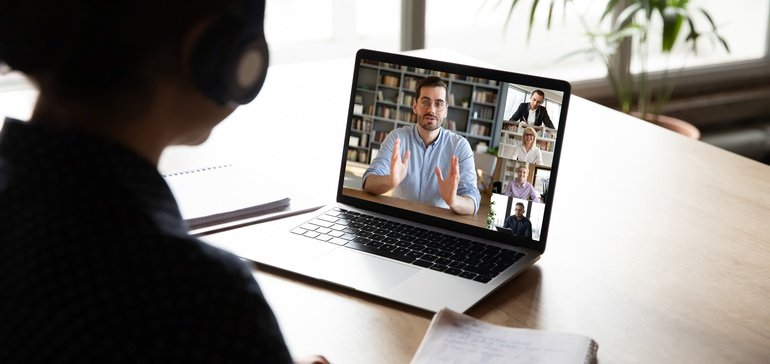
Today, recruiters can whittle an applicant pool down to a short list before speaking to candidates. And someday soon, they might not need to interact with potential hires at all.
Adoption of recruiting technology is speeding up as employers have had to take many processes virtual. While software and automation have mostly been aimed at the top of the recruiting funnel, applications continue to march forward into more complex stages of the talent acquisition process.
“Something we suspected before the pandemic is that organizations don’t have a lot of necessary data to make adaptive, forward decisions” in the recruiting process, Mark Brandau, principal, head of the global HCM/Talent practice at Forrester, told HR Dive in an interview. “[Employers] either want to automate that more because of high volume, or they want to find better quality candidates.”
Tools like virtual assessments, “on-demand” video interviews and job simulations are making progress on that front. Some organizations implemented them after shelter-in-place orders took effect. But many others were already using them as a way to be more accessible to candidates, and are now using them more. Brandau and others suggested recruiting automation will gain support during this pandemic-driven expansion.
These technology solutions are supporting the “post-apply to hire” stages, Mike Hudy, chief science officer at Modern Hire, a recruiting platform that includes interview technology, assessments and scheduling tools, told HR Dive; workflows that combine these things can drive automation of hiring but also effectiveness, he said.
Traditional video calls can get the job done, but have their limitations and take up a lot of recruiters’ time. The promise of these on-demand interview and assessment solutions is to evaluate every candidate consistently with the precision of an expert interviewer and go beyond a resume, Kevin Parker, CEO of HireVue, a video interview and pre-hire assessment provider, told HR Dive. His company’s clients include PwC, Delta, Vodafone and Unilever.
“We can test for cognitive abilities using game-based assessments [such as] a memory challenge, a puzzle or pattern recognition,” Parker said. “We can test a variety of attributes, then we also have the ability to understand and use artificial intelligence to analyze the answers people are giving to questions, the words they’re using, the way they’re describing their experiences, and how those relate to the qualities that companies are looking for.”
Parker also noted the fallibility of human interviewers, including a proclivity to anchor perceptions on similarities they may share with candidates. Preventing this force from influencing which candidates advance can also improve the fairness of the process, Parker said.
“A lot of the work that recruiters have been doing historically wasn’t actually interviewing people,” he said. “It was trying to schedule people, doing follow up phone calls, phone screens and things like that. When you can automate a lot of that process, the recruiter can really focus on people that are most qualified for the position.”
Necessity drives innovation
Efficiency, effectiveness, fairness and candidate experience are the four goals Hudy said employers should aim for in the talent acquisition process. Before the pandemic, candidates held the upper hand in a job market that favored workers. Employers were using technology to stand out in a competitive recruiting market.
“We didn’t want candidates dropping out of our process,” Hudy said, emphasizing the pre-pandemic focus on candidate experience and “just trying to connect” with them. Hudy explained how the recruiting climate quickly “flipped” from employers having “lots of jobs and fewer candidates” to “fewer jobs and candidate abundance,” leading to a point where candidates are willing to “put up with a little bit more and go through the process.”
With more job seekers, and changes to workforce strategy for many companies, business leaders are adapting by using more technology and using it further down in the recruiting funnel. At ModernHire, Hudy works on virtual, automated interview software and a pre-hire assessment called Virtual Job Tryout. CVS was among the many companies already using Virtual Job Tryout that expanded their use as it added nearly 50,000 new employees in a little over a month.
“We’ve been working with [CVS] for 10 years, and we’ve got data, do constant analysis on how they relate to performance and how they relate to turnover, ensuring that they don’t have adverse impact,” Hudy said.
The tryout offers a window into a candidate’s likelihood of success at the company in ways that a simple interview would have trouble with, Hudy said. It also engages candidates with information about the company and role and provides them with a window into the work experience.
“The virtual job tryout typically consists of some kind of realistic job preview,” Hudy said. He used CVS as an example to explain the tryout portion for a retail associate role: “You’re going to have simulated customer interaction,” he explained. “We put them into six customer service scenarios in the store. Then we put them into an inventory checking simulation with products and checking skews.”
This level of two-way interaction, including a realistic job simulation for the candidate, benefits both parties, according to Hudy, because the employer receives data on candidates’ fit and job potential, and candidates get a realistic view of the job responsibilities.
A new candidate experience
While some companies, like CVS, may have been ready to deploy a fully virtual recruiting process, Hudy noted that some had to make a push in technical maturity. Both he and Parker said they have experienced significant increases in customer usage and new client interest at their respective companies.
With the future outlook favoring remote work or at least flexible remote options — and the benefits to the candidate, such as avoiding time and travel to an office — some form of automated, virtual interviewing and assessment is likely to remain part of the recruiting tech stack, experts suggest.
“[The pandemic] is going to change the way we hire for good,” Hudy said. “So doing a live interview with technology, you’re using technology, but you’re just facilitating a face-to-face. You’re facilitating a labor intensive step in the process. It’s not that you don’t need that process, but that it’s really good at the very end of your process.”
The convenience to candidates to engage virtually and on their own time can be profound. Saving time to travel to an office and coordinating schedules with a recruiter, especially if a candidate is already employed, can often mean waiting weeks between rounds of interviews.
“Eighty percent of our interviews take place outside of normal work hours,” Parker said, “40% of them take place on a mobile device. So here you are interviewing for a new job at night on a weekend on your phone, and you’ve got improved access because the logistics and scheduling aren’t in the way.”
Ultimately, efficiency and quality of hire may be the primary offings these new recruiting assessments bring. But access matters as well, and virtual solutions make interviewing more accessible to a wider range of people, which could also support diversity recruiting efforts.
“We’re in this really interesting transition where access to available talent is more important than ever,” Parker said, referring to the expansion of remote work. “We’re trying to make it as easy as possible for candidates, so you can interview for five jobs this afternoon and never leave home. That’s democratization of the process in a new way.”
